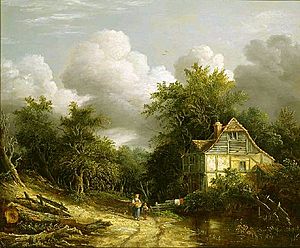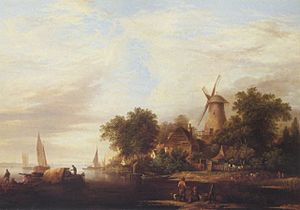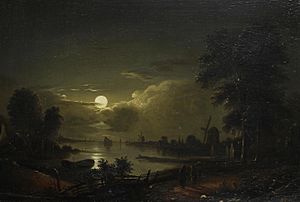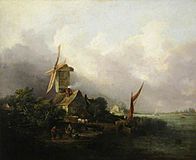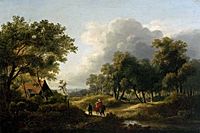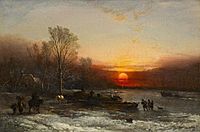Edward Williams (painter) facts for kids
Edward Williams (born 1781 – died 1855) was a famous English landscape painter. He lived during the Victorian era. Edward Williams had six sons who also became well-known landscape painters.
Williams is often called the "patriarch" (or leader) of the Williams family of painters. This group of artists is also known as the Barnes School.
Contents
About Edward Williams
His Life and Painting Career
Edward Williams was born in London in 1781. He was baptized on October 13, 1781, in the Lambeth area. His mother, Mary Ward, had several famous artist siblings. These included James Ward, a well-known animal painter, and William Ward, a famous engraver.
His father, also named Edward Williams, was an engraver too. Young Edward grew up surrounded by talented artists.
Around 1792, young Edward Williams went to live with his uncle, James Ward. It seems he didn't learn painting from him directly. Instead, he learned from a carver and gilder named Thomas Hillier.
Edward Williams eventually became a painter. He chose to paint landscapes, which was a bit unusual then. Landscape artists were sometimes seen as less important than painters of people.
Even though he wasn't as famous as his uncles, he earned a good living. More importantly, he had six sons. All of them became artists like him. They continued the landscape painting styles he taught them. Some of his sons became very popular landscape artists during the Victorian era.
Edward Williams spent most of his life in London. In 1846, he moved his family to Barnes, Surrey. They lived in a large house with a studio in the back. Three of his older sons moved to nearby houses.
In Barnes, near the Thames River and farm fields, the Williams family worked together. They painted hundreds of similar landscapes. This is why they became known as the "Barnes School" of artists. However, they are more commonly called the "Williams family of painters".
Edward Williams showed his art in many exhibitions between 1814 and 1855. He exhibited at the Royal Academy (36 works) and the British Institution (21 works). He also showed paintings at the Society of British Artists (38 works).
He often exhibited his paintings alongside his sons. This sometimes made it hard for people to tell their paintings apart. Edward Williams is often called "Old Williams" to tell him apart from his oldest son. He was also known as "Moonlight Williams" because he loved to paint moonlit scenes of the Thames.
Edward Williams passed away on June 24, 1855, in Barnes. He is buried in Barnes Cemetery.
Meet the Family
Edward Williams was the son of engraver Edward Williams and Mary Ward. He married Ann Hildebrandt in 1806 in St Pancras, London. They had eight children together.
Three of Edward and Ann Williams' sons later changed their last names. They did this so people wouldn't confuse their paintings with the rest of the family's art.
Here are their children:
- Edward Charles Williams (1807–1881)
- Henry John Boddington Williams (1811–1865)
- George Augustus Williams (1814–1901)
- Arthur Gilbert Frederick Williams (1819–1895)
- Emily Ann Williams (1816–1857) - she was the mother of landscape painter Charles Leslie
- Sidney Richard Percy Williams (1821–1886)
- Alfred Walter Williams (1824–1905)
- Charles Williams (1824 – died shortly after birth)
Edward Williams' Art
His Painting Style and Influence
Edward Williams likely started his art career by making picture frames. But he was surrounded by famous artist relatives. Over time, he became a painter himself.
He began by painting tiny pictures called miniatures. He also copied old landscapes from the 1600s. These were in the style of Dutch painters like Ruisdael and Hobbema. Ruisdael was known for detailed trees and water scenes with windmills. Hobbema was famous for his thick, leafy trees.
As Edward Williams developed his own style, he started painting English countryside scenes. These paintings sometimes looked a bit like the work of his uncle George Morland.
However, he became most famous for his moonlit scenes. These often showed boats and windmills along the Thames River. This is why people called him "Moonlight Williams." He rarely signed his paintings, maybe only one in a hundred. When he did, he signed simply as E.Wms.
Because of this, it can sometimes be hard to tell his work apart from his son Edward Charles Williams's paintings. His son painted in a similar style and signed his art E. Williams.
After he passed away, a magazine called The Athenaeum wrote about him. They said he was a "pleasant landscape painter." They also noted that he "trained what must almost be called a school of landscape painters in his sons." This shows how important he was in teaching his children.
Edward Williams was great at painting detailed country landscapes. In his paintings, people were usually small and less important than the scenery. But he is best remembered for teaching this style to his six sons. Some of them became very popular landscape painters of their time.
Examples of His Paintings
Here are some examples of Edward Williams' artwork, showing how his painting style changed over time.
-
Edward Williams
A Squally Day on the Yare, Norfolk
(in the style of Ruisdael) -
Edward Williams
Returning Home
(in the style of Hobbema)
Where to See His Art (Museums)
You can find Edward Williams' paintings in these museums:
- Anglesey Abbey, Lode near Cambridge, England
- Leeds Art Gallery, Leeds, England
- Castle Museum and Art Gallery, Nottingham, England (2 paintings)
- Tate Gallery, London, England (2 paintings)
- Temple Newsam House, Leeds, England
- Victoria and Albert Museum, London, England
- York Art Gallery, York, England


